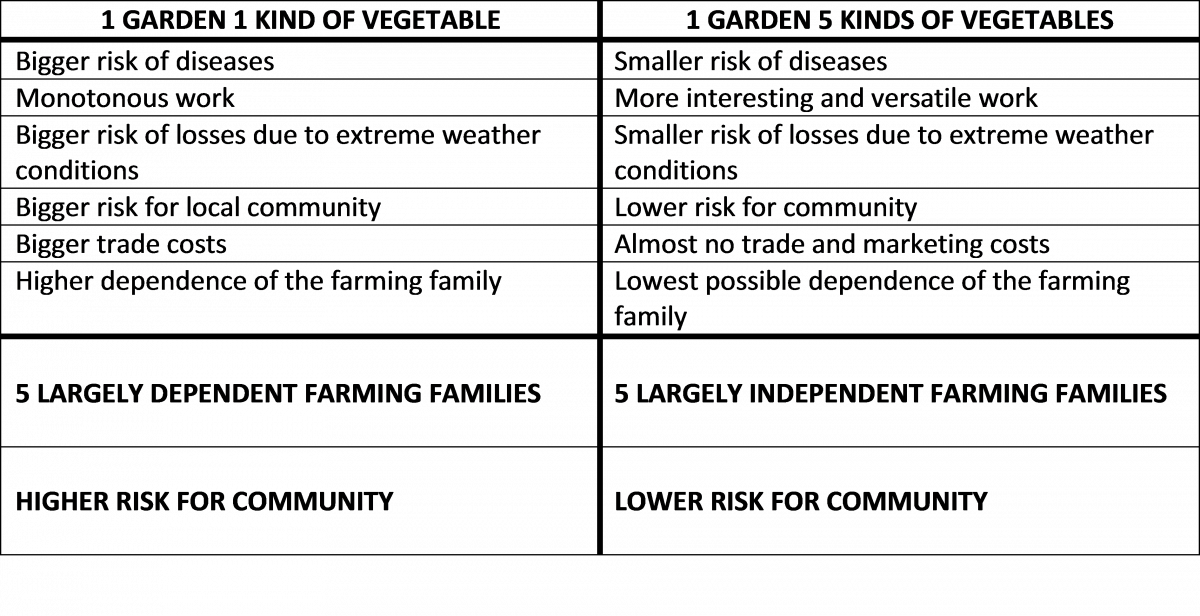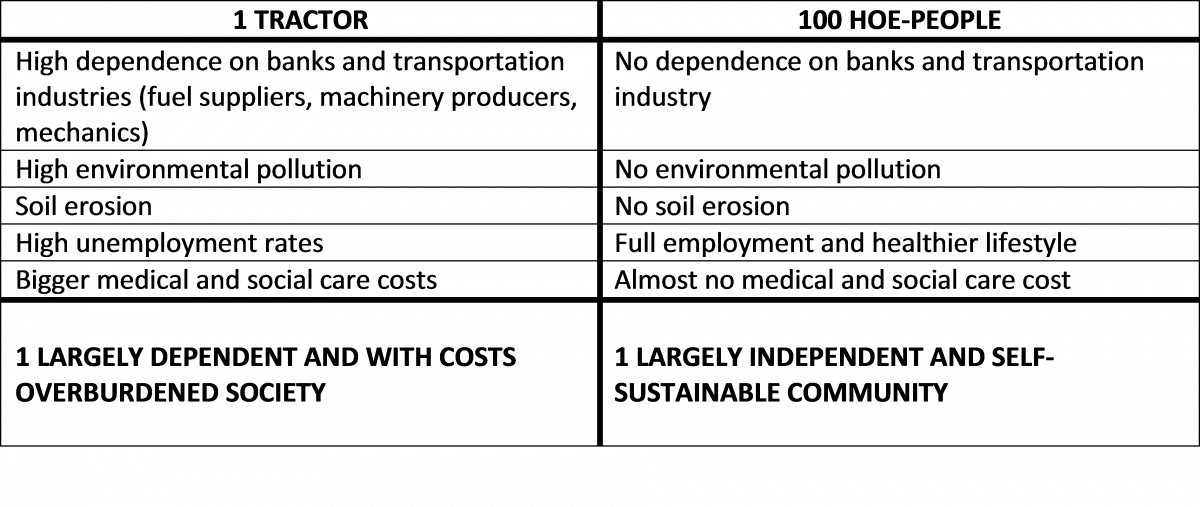Not only. Let's examine this on a few examples: Is it better to have 1 family farm with 100 cows or 100 family farms with 1 cow? Here is the table of traits of these two options.

So, which one is better? It largely depends on our position. If we work in a bank or machine- or transportation-industry we would prefer 1 farm with 100 cows. But if we prefer independence, healthy lifestyle, strong local community and landscape preservation we would prefer 100 families with 100 cows.
So, small is not only beautiful, more vivid and colorful. It is also self-sustainable. It is that without which the big cannot exist. If we want the big to function properly, the wellbeing of the small must become our primary concern. In that sense the small is a lot bigger that big in its usefulness and practical application. For our students we would want smaller books but numerous small everyday
professional experiences which would nit a tight net of unshakable competence. It also makes small desirable.
The Five gardens example
Let us examine another example. Imagine 5 neighboring gardens. Is it better that every garden is specialized in growing one kind of vegetable or it is better that every garden grows all necessary kinds (a little bit of everything)? Here are the traits of these two options:

When every garden grows every kind of vegetables that local community needs, they apply one of the basic economic rules which is “do not hold all of your eggs in one basket”. It is important to apply this rule also when the time is considered as a resource. This means that we should invest our time not only in one activity, but in more different activities. So if we have a garden, the overspecialization creates much more problems than growing different kinds of vegetables that we consume. It is dangerous to invest all of our time into one activity.
The 100 hoe-people example
Is it better to cultivate the land with 1 tractor or with 100 hoe-workers as an equivalent?

So again, it seems that smaller is better for numerous reasons.
Why beautiful?
But why would small be beautiful? It might be so because beauty in itself is a matter of personal choice. The small things have a lot bigger chance of being personalized. Small things can be produced by a single person. We are all, as humans, very limited beings. We can only live for 3 minutes without the air, 3 days without water and 3 weeks without food. Or, as Sting famously sings “how fragile we are”. So as fragile individuals we can create only small personalized things that meet our esthetic requirements. Therefore the small is personal and personal is inevitably beautiful.
The story of the monkeys in the cage
Once upon a time some scientists undertook a social experiment on monkeys. They put 6 monkeys in a cage and hung a bunch of bananas on the top. When monkeys tried to get the bananas they were aggressively sprayed with water cannons every time they tried. Since this practice was extremely unpleasant monkeys developed the following strategy: if among them there was a monkey who could not restrain his instinct to reach for bananas the others beat him to prevent water-cannoning. The scientists then took one of these monkeys out of the cage and replaced him with a new monkey who never had the “water cannoning experience”. He reached for bananas and he was automatically beaten by the rest of the group. Then scientists took out, one by one, all the “old” monkeys that had the water-cannoning experience and replaced them with new monkeys. In that process it was observed that the new monkeys, although never water-cannoned, gradually became the beaters of the freshly introduced monkeys. They acquired the behavioral pattern of the group by imitating others. Of course, by doing so they saved themselves from being beaten. Monkeys were successfully trained to consciously deny their instinct to reach for their natural food. This experiment pointed out the same behavioral pattern in humans. People tend to repeat the unnatural behavioral patterns although the original unpleasant event took place so long ago that no one of the living members of the community can remember it.
By the same principle we have gradually learned that big is viable, nice and only possible. Big farms, big cities, big factories, big cars, big consumption, big banks, big loans, big machines. We can hardly reach into the time when all of this was aggressively introduced to our communities. There is a story that could make this point much clearer. After the Second World War, around the town where I was born, the young members of the communist party were visiting the surrounding villages, properly armed with pistols and machine guns, and were ordering the local people to go to the city and get the job in the local factories. Those of the village people who were that day doing something in the fields or somewhere else, stayed in the village for the rest of their lives, but those who were “caught” in the village and ordered to go to the factory, and were promised a salary and a flat for their family, ended up, 60 years later, as a retired industry workers. This was undoubtedly a forced de-agrarization, forced industrialization, and the most practical application of the shock doctrine. So, from today’s perspective, we might conclude that our mainly industrial civilization is natural and only possible, but our “monkey story” tells us that our ancestors were forcibly driven away from their natural, much more independent way of life a long time ago. As scientist, we now work for this new system, trying to fix its problems, but we’re not fast enough. Every day the system creates much more problems than we can solve. As humans, at least theoretically, we should aim at discovering the cause of the problem. If we do it properly the simptoms will disappear automatically.
Saying that small is better largely contradicts the contemporary mainstream economic narrative. The “big is better” paradigm might be a forced mind set, automatically passed from one generation to another. Is it so?
Denis Cvitkovic, Zagreb, Croatia

Comments
Denis has provided us with an
Wed, 12/03/2014 - 16:52 — Jonathan RushtonDenis has provided us with an important reminder that the the world is partly shaped by the institutional environment - the rules we accept and observe. This environment has an important bearing on resource prices and hence a very big impact on decision making with regards resource allocation.
On the general topic of big and small, we should perhaps spend some time on thinking of the implications of the drive towards larger livestock units, livestock processing facilities. These have important implications on disease management that affect individuals, companies and governments.
Jonathan Rushton
Professor of Animal Health Economics
Royal Veterinary College
Add new comment